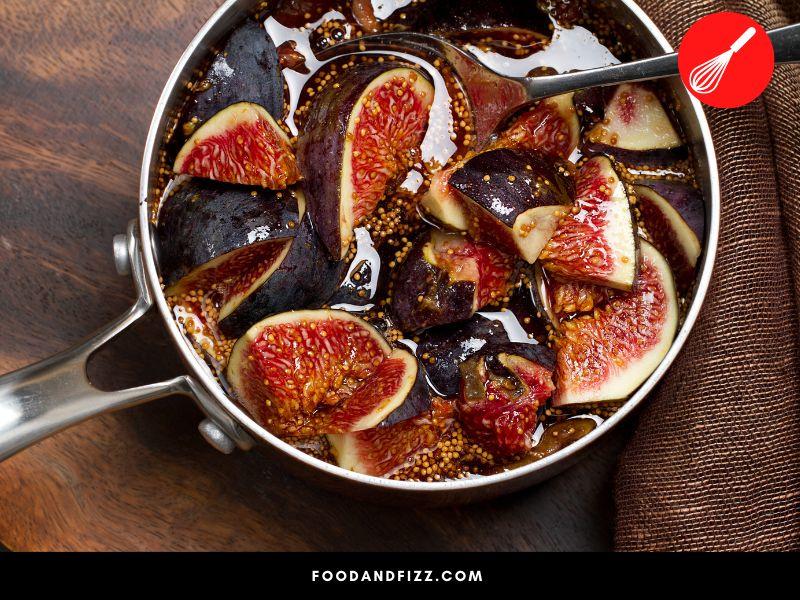Figs are round, dark purple or black fruits merely the size of your thumb. They are roughly 1 to 1.5 inches in diameter.
Figs are delicious, low-calorie fruits with multiple benefits and health advantages. They have many essential nutrients and enzymes that help improve your health while keeping your calorie count low.
How to Freeze Figs
To freeze figs you can freeze them individually or freeze them using syrups or sugar. Figs can be frozen for up to eight months and can be used in various desserts, jams, smoothies, and other baked goods. While mostly figs are eaten fresh, they can be preserved or frozen for later use. There are different types of figs and various methods to freeze them.

Figs are eaten and used in many dishes in fresh form depending upon the type of dish. However, you can preserve your figs by freezing them. There are many ways in which figs can be frozen for later use.
You can peel them or leave them unpeeled and even cut them in half before freezing. Following are some ways in which figs can be frozen.
In Syrup
Using syrup is considered the best way of freezing figs because it helps restore their taste. You can create a syrup by mixing 2 cups of water and 1 cup of sugar.
You can also put ascorbic acid in the syrup to help restore the color of your figs. The ascorbic acid should be a three-fourth teaspoon into each batch.
Pour the syrup into a container for up to one-fourth. Add your figs into the container. Ensure that they are packed. Fill the rest of the container with syrup and leave one-inch headspace before covering the lid.

Sugared Freezer Method
It is not necessary to make a syrup to freeze figs. You can only use sugar to freeze your figs by adding sugar and figs in a container by a ratio of 1:5. Pack them tightly in an air-tight container and freeze.
It helps restore the taste for later use.

Without Sugar
If you wish to freeze your figs without any sugar, you can use a commercial ascorbic acid mix to freeze them. Sprinkle the acid mix on the figs and place them in the freezer on a baking sheet.
Put them directly at 0 degrees for quick freezing. Once frozen, take the figs and pack them in a freezing bag or container, making sure that the container or plastic bag is air-tight.
Individual Freezing Method
If you wish to avoid the process of making the syrup or ascorbic acid, you can simply freeze your figs directly.
Take some ripe figs and place them in the freezer on a baking sheet. When they’re frozen, put them in a container or freezer bag.

Tips for Freezing Figs
- Make sure you pick the softest and ripe figs for freezing. The ripest figs have the best flavor.
- The container you are freezing them in must be air-tight, and there should be no holes to facilitate any sort of airflow.
- Keep in mind that frozen figs have a different taste and texture than fresh ones. So, make sure that their use should be according to their changed texture after you defrost them.
- You can fill the containers and plastic bags with crumpled wax paper along with the fruits and syrup so that the figs remain dipped in the syrup.
- Filling the plastic containers with wax paper also helps in creating the bag more air-tight.
- Do not use overripe or seeping figs to freeze because they will not freeze well.
- Place your figs at a distance from other fruits in the refrigerator because they can cause the other fruits to decay quickly.
- Cutting up the figs into smaller pieces will help you use them in smoothies and other bakery items with more ease.
- Frozen figs are mostly sweeter than fresh figs when defrosted because of the sugar coating and syrups.
- Use citric acids in the syrup or other coatings if you do not want the fig to darken.
- It is best to refrigerate your figs if you are freezing them directly. Refrigerating them helps retain the texture for a more extended period.
- Figs can be refrigerated for up to 7 days.

Things to Look Out for
Certain things should be looked out for when you are freezing figs. If your figs are developing a foul odor, that means that they are not appropriately frozen and have gone off.
It is best to throw these figs out because they are inedible.
Apart from that, figs can also develop a mold if the container or plastic bag is not air-tight. Mold is usually in the form of a white powdery substance on top of your figs.
If you did not use the sugar method to freeze your figs, then it is easier to identify that the powdery substance is a mold. On the contrary, if you use sugar and can’t figure out if the substance is sugar or mold, it is advised to throw those figs away to avoid any risks.
Figs also have the tendency to clump together. If you do not want that, place them on a baking sheet apart from each other so that they do not touch each other.
Conclusion to How to Freeze Figs
Figs are a delicious and sweet fruit that can be used well after the growing season using many freezing techniques. Even with the changed taste and texture, figs can still be used in many pies, cakes, smoothies, and further preservation in the form of jams.
Frequently Asked Questions to How To Freeze Figs
Can you Freeze Cooked Figs?
Cooked figs can be frozen but keep in mind that their texture will be changed tremendously when you defrost them.
How Long can Figs be Frozen?
You can freeze your figs for up to 6 to 8 months. They can also be refrigerated for seven days before freezing.
Can You Freeze Figs Before Making Jam?
You can freeze your figs in syrup or without syrup before preserving them as jams.

